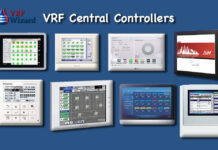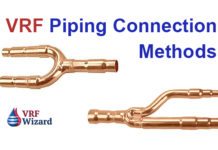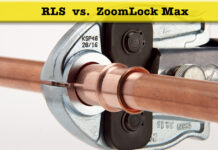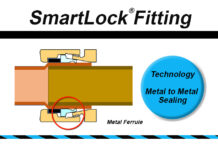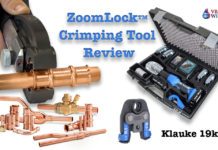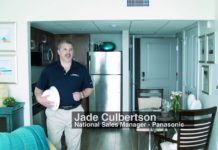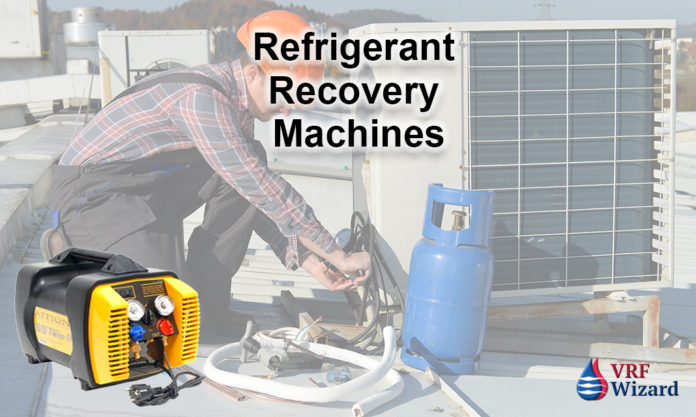Refrigerant Recovery Speed
Using the 80/20 rule, where we assume that 80% of the refrigerant recovered will be in vapor form and 20% will be recovered in liquid, we have created the following chart. After this chart are additional charts based on the speed of recovering either liquid or vapor separately. Based on the refrigerant recovery machines reviewed and using the 80% Vapor/ 20% Liquid assumption for R410A, here are the results of the calculation.
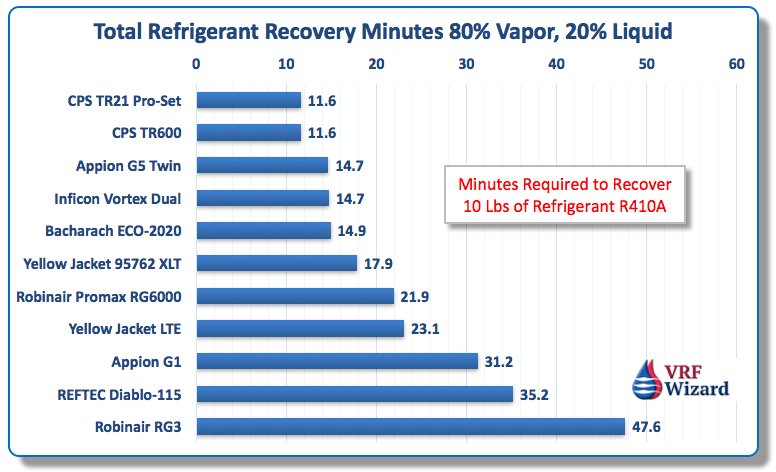
Liquid Recovery Speed
How long do these refrigerant recovery machines take to recovery liquid or vapor refrigerant independent of the ambient temperature? Recovery times vary depending on the power of the unit and whether you have a twin or single cylinder engine. We all know time is money, but does the extra cost make sense for the time saved?
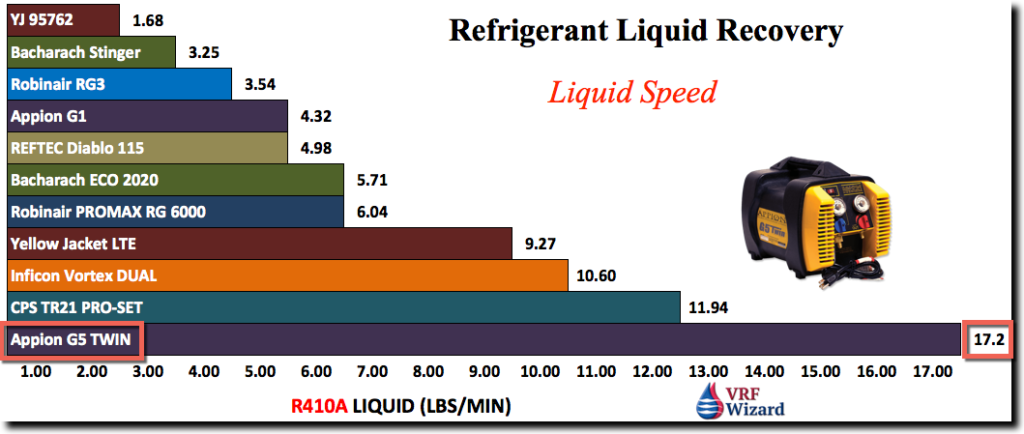

Vapor Recovery Speed
Another measurement of the machines ability to recovery refrigerant based on speed.
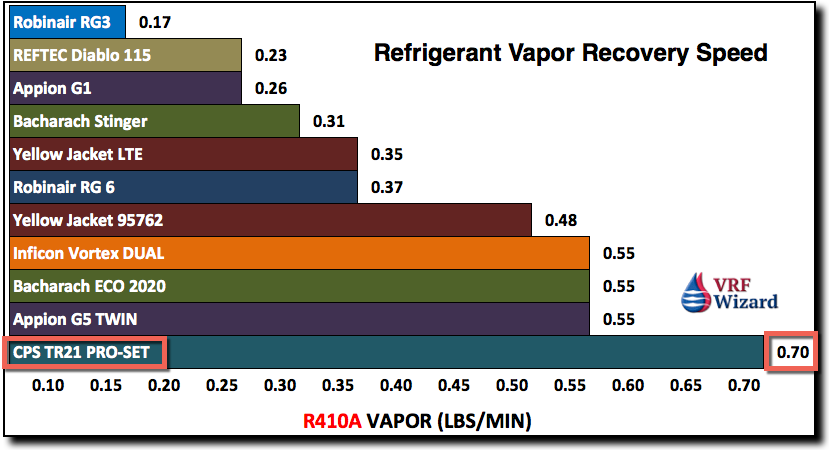

Refrigerant Recovery Review – Weights
You need to consider your typical working environment and the difficulty of lugging around the refrigerant recovery machine. Where do you usually find the outdoor units that you serve? Most likely they are found everywhere, from the roof to various nooks and crannies around the property, as the owners or builders try to hide them for aesthetic reasons.
Being able to easily bring your refrigerant recovery machine to where you need it without risking your safety is an important consideration. This will involve reviewing the weight and physical dimensions of the refrigerant recovery machine and if they come with a shoulder strap or harness. Below are the weight of the Refrigerant Recovery Machines reviewed.
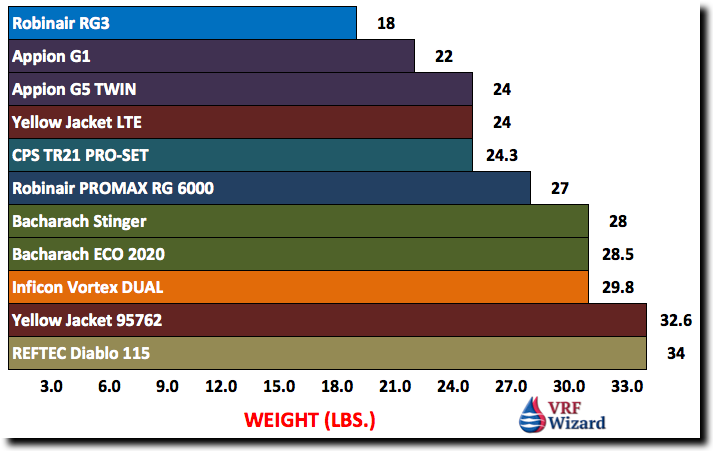

Refrigerant Recovery Methods
There are three common methods for recovering refrigerant used by the rating authorities (AHRI or UL) as shown below. Some manufactures use a combination of these or advanced versions of the following.
- Push-Pull Liquid Recovery
- Vapor Recovery
- Liquid Recovery
Make sure that the refrigerant recovery machine that you are using is rated to handle liquid refrigerant. Compressor are made to compress vapors and liquid isn’t compressible, but some recovery units are designed to handle incoming refrigerant in various ways. One way is with the use of a CPR (Constant Pressure Regulator) valve that meters the liquid refrigerant coming into the compressor.
Vapor Recovery Method
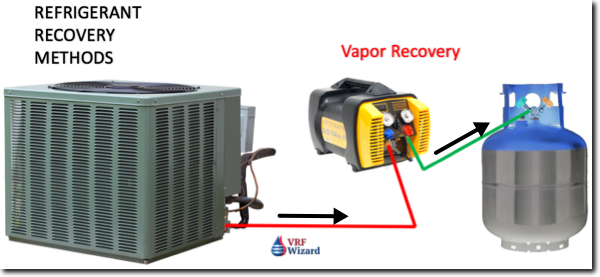

Push-Pull Recovery Method
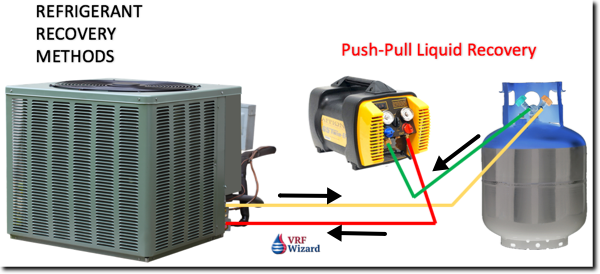

Liquid Recovery Method
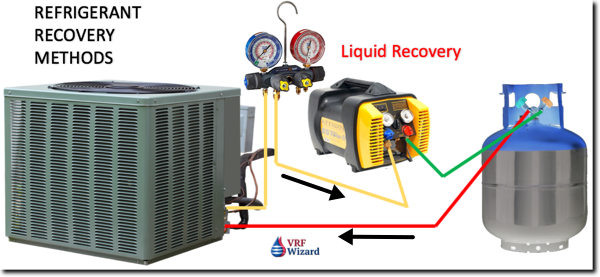

Liquid & Vapor Recovery Method
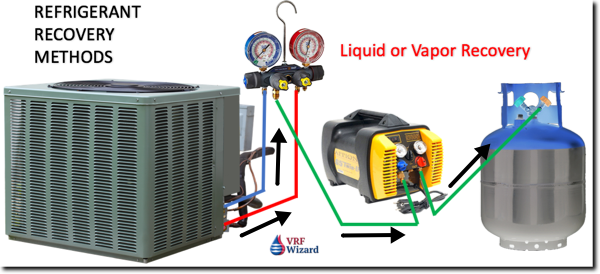

Price
The price of refrigerant recovery machines vary from under $500 to over $5,000 depending on many variables and features. Finding the one or two units that you use most often will depend on your current and expected future needs.
Warranty
Reviewing the warranty period and what is covered under the warranty will help to understand how the manufacture views their refrigerant recovery machines ability to stand the test of time. Most refrigerant recovery machines come with a 1 year warranty, some have a 3 year warranty on the compressor.
Serviceability
What happens when your refrigerant recovery unit doesn’t work? Can you service the unit in the field or do you have to send it to the manufacturer?
Weather Conditions
If you normally work in a geographic area that has extremely hot weather, than you might want to make sure your refrigerant recovery machine has an oversized condenser to help cool the unit and keep it from cutting out on high ambient.
Certification of Refrigerant Recovery Machine
“Except for equipment manufactured before November 15, 1993, the recovery or recycling equipment must have been certified by an EPA-approved equipment testing organization. To ensure that they are recovering the correct level of refrigerant, technicians must use the recovery equipment according to the directions of its manufacturer.” – EPA
Refrigerant Reclamation Requirement
Recovered refrigerant can be returned to the same system or other systems owned by the same person without restriction. However, if recovered refrigerant changes ownership, it must be reclaimed. You can’t use the refrigerant from one building on another building without having it reclaimed by an authorized reclamation company as listed on the EPA’s website.
Recommended Best Practice
- Use 3/8” hoses to speed up recovery. The smaller 1/4” hoses used for charging restrict the refrigerant recovery time, slowing down the recovery and costing you time and money. Also, make sure the hoses are as short as possible, because all the refrigerant left in the hoses will be lost after the recovery is done. The refrigerant recovery machine will only pump the refrigerant as far as the top of the compression cylinder on the last stroke.
- Make sure the recovery tank is rated for the refrigerant being recovered.
- Never fill a recovery cylinder more than 80% of its capacity. This will help prevent explosions or venting.
- Make sure that you start with a clean recovery cylinder. Evacuate cylinder to below 500 microns to avoid any non- condensable or moisture that maybe residing in the recovery cylinder which will contaminate the recovered refrigerant.
- Make sure that the recovery cylinder has been used only with the type of refrigerant that you are going to recover. You don’t want to mix refrigerant types in the same cylinder otherwise you won’t be able to get it reclaimed.
- Remove access valve cores for faster recovery using an access valve core removal tool. The Schrader access valve core blocks up to 90% of the flow.
- Make sure to connect the hose to the vapor side of the refrigerant cylinder tank, as the liquid side is restricted by a long tube that goes from the top of the cylinder to the bottom of the tank.
- If you hear a knocking or rattling sound coming from your refrigerant recovery machine, it might be because of a restriction on the discharge of the machine. Restrictions can cause hot tanks and knocking during recovery.
- After connecting the hoses to the air conditioner, refrigerant recovery machine and refrigerant cylinder, you’ll want to purge the hoses. You don’t want non-condensables because it always slows things down. You want to make sure that you are complying with the EPA’s de Minimis rules, so you want to make sure you are purging just enough to remove air from the hoses and not more than legally allowed.
- Make sure you have a new filter drier on the inlet of the refrigerant recovery machine for ever recovery job. Some machines come with a filter, others don’t.
- Make sure to wear proper PPE (Personal Protection Equipment) when working.
- Remember it’s important to have a clean refrigerant cylinder, especially if you are reclaiming it to put back into the system, as you don’t want to add non-condensable or moisture into your newly repaired system.


